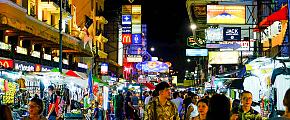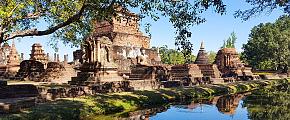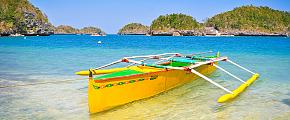Sukhothai Travel Guide
Sukhothai, which in Thai means "good beginning," is where Thai civilization first emerged. The Sukhothai Dynasty, Thailand's first dynasty, founded its capital here as early as the 13th century and prospered for several decades before being slain by neighboring kingdoms in 1438. Given its proximity to Bangkok and Chiang Mai, Sukhothai makes for a convenient pit break on the way to other parts of Thailand. The Sukhothai Historical Park, the most magnificent remnant of the Sukhothai empire, and Thailand's Loy Krathong Festival are both located in Sukhothai. The park is divided into five parts, with the most well-known Wat Mahathat - the biggest temple in Sukhothai - located in the center. The other remaining regions each have unique landscapes. Go to Sukhothai and enjoy the traveling.
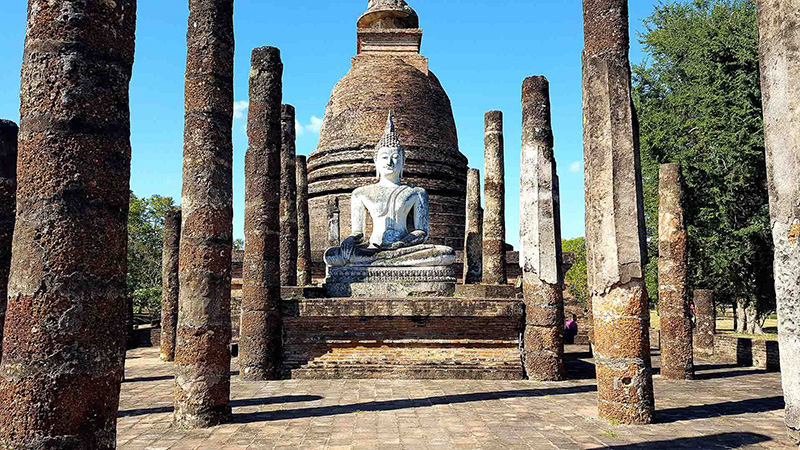 Sukhothai
Sukhothai
Best Attractions to Visit in Sukhothai
1. Ramkhamhaeng National Museum
Nearby Sukhothai Historical Park, the Langanhang National Museum is home to several significant statues and antiques. Sukhothai-style Buddha sculptures, which are also regarded as exquisite emblems of the Buddhist image in Thailand's past, are on show at the museum, adding to its allure. If you're interested in Thai history, the museum also contains other items on Sukhothai and other Thai dynasties. The collection perfectly exemplifies the subtle variations in the aesthetic of Buddha statues, ranging from native Sukhothai antiques to Chinese ceramics in the Sukhothai style. The evolution of the Thai language is also depicted on the museum's walls, which is intriguing and informative.
2. Wat Mahathat
The Wat Mahathai at Sukhothai is the largest structure in the entire Sukhothai Historical Park and the principal temple of the Sukhothai dynasty. There are hundreds of pagodas around the complex that are all covered in tall trees, and the temple is ringed by a brick wall and a lotus pond. The Wat Mahathai's interior, which reflects Buddhist principles, is designed in the Khmer style, while the exterior is constructed in the traditional Sukhothai architectural manner. The main stupa at Wat Mahathai is composed of red earth and stucco, and it has a carving of Buddhist hands clasped together and a top in the shape of a blooming lotus flower in the classic Sukhothai style. Small pagodas with shrines and pagodas that resemble templates surround the main stupa. A nice site to enjoy the sunset and nighttime scenery is Wat Mahathai. The Buddha's reflection in the pond in front of the main hall can be seen in the afternoon. It is both holy and lovely.
3. Wat Sa Si
In the northwest corner of Sukhothai Historical Park is Wat Sa Si. On a small island in the Lotus Pond, a wooden bridge connects to the temple's main hall. The temple is serene and enigmatic, set around a lagoon filled with lotus blossoms. The Wat Sa Si has a unique design compared to the others. There are several pagodas all around the main pagoda. The main stupa is a bell-shaped stupa in the Sinhalese style; comparable structures can be seen in historic Sri Lankan cities. There are numerous lesser pagodas behind the big one, but they are all now little more than ruins. The assembly hall is in front of the pagoda, and you can still see the remaining base and rows of pillars. A Buddha statue in front of a stupa can be found on the left. This statue is known as the "walking Buddha" because it is different from the others in that it is standing and moving. Another noteworthy feature of Wat Sa Si is the Buddha statue. The Buddha statue is vividly crafted, displaying the exceptional artistic achievement of the time. This exquisite Buddha was also sculpted in a manner that is exclusive to Sukhothai, where similar statues cannot be found elsewhere.
4. Wat Si Chum
Wat Si Chum is a wall-only structure that is a part of Sukhothai Historical Park. It has no roof. The temple, which dates back to the 13th century, is home to the sole open-eyed Buddha figure found in Sukhothai. The Buddhist hall behind the main hall is the major structure of Wat Si Chum. The entrance is in front of the Buddhist temple. It is considerably smaller than other temples. There used to be a roof covering the cracked pillars outside the hall, but it is now missing. The Buddha, who stands 15 meters tall and has thin fingers, is masterfully made. In stark contrast to the Buddha's initial black-and-white coloring, devout worshippers now adorn the Seated Buddha's fingers with gold leaves. The Buddha's "golden fingers" are likewise well-known throughout the nation. The Buddha, a historic statue that embodies both the Sukhothai era and the beauty of modern Buddhas, may be felt even from a distance. For visitors to Sukhothai, Wat Si Chum is a must-see location, and many people come here to worship the enormous Buddha. Only in person can one experience the awe and shock of the gigantic Buddha and the spectacular remains of Wat Si Chum.
5. Wat Si Sawai
Wat Si Sawai is a temple inside the old city walls next to the Namo Gate. Wat Si Sawai is a serene temple surrounded by red earth walls and the famous lotus pond. One of Sukhothai's oldest temples, it is made up of two viharns and three Khmer-style prangs that were later transformed into the current Buddhist temple. Three perfectly-preserved spears in the shape of corncobs are the main attraction of Wat Si Siwai. The promenade, which is made of white stucco and sits on a plinth surrounded by galleries, is about 15 meters in height, the towers on either side are a bit lower, and the central stupa is about that height as well. Like the Naga Serpents, Makaras, and Kala, mythological creatures, the three Prangs are also sculpted in relief. The auditorium, whose exterior walls are still in good condition, is located in front of the main square. Wat Si Sawai is a fantastic option if you're seeking a peaceful temple to visit.
6. Si Satchanalai Historical Park
Si Satchanalai Historical Park is made up of the ruins of an ancient city with several temples, similar to Sukhothai. The Yom River banks host Si Sachanale Historical Park, the second-largest city in Thailand after Sukhothai. The three main sites, Wat Phra Si, Wat Chang Lom, and Cheri Jet Taew, are all constructed in the traditional Sukhothai style. A temple surrounded by elephants is another translation for Wat Chang Lom, which is located in the middle of the historical park. The great stupa in the Lankan style is the most significant historical structure at the site. There are 39 elephant-shaped statues carved into the oddly-shaped pagodas on the barren plains. These elephant sculptures depict the elephant in a standing position, which is a symbol of inner strength. The well-preserved stucco reliefs of Wat Phra Si, the lotus-shaped stupa of Wat Chedi Ched Thaeo, and Wat Nang Phaya, one of the oldest temples, all have unique qualities that are well worth visiting. This explains why so many people visit the Si Satchanalai Historical Park.
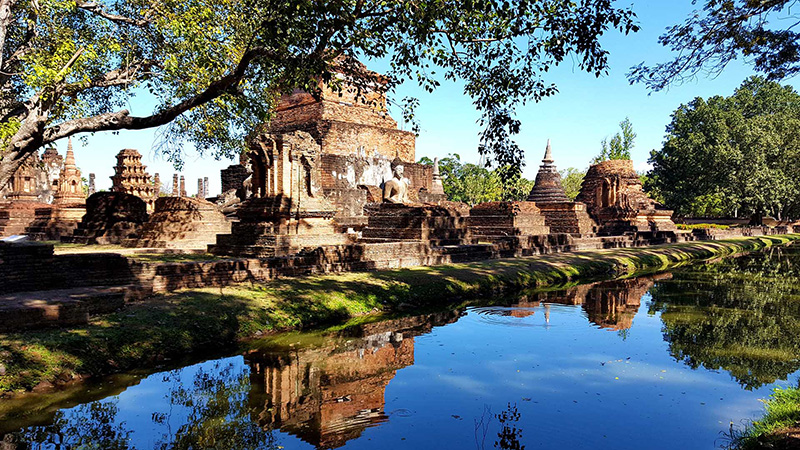 Historical Park
Historical Park
Special Food Not To Be Missed
Sukhothai Noodles
No matter where you go in Thailand, you can find Sukhothai rice noodles, but the real deal can only be found in Sukhothai. The way Sukhothai noodles are prepared, which is separated into dry noodles and wet noodles, is what sets them apart from other noodles. The original Sukhothai noodle recipe has to incorporate strong, spicy soup and a lime smell to go with the noodles' ingredients. Sukhothai noodles are sweeter and sourer than conventional Thai noodles, with fish sauce and crushed chilies added, along with a choice of minced pork and barbecued pork, and are served with green beans, salted turnip, peanuts, and lime juice, unlike the rest of Thailand. It has a lot of flavors and is rich. There is no doubt that the Tom Yum Gong soup, whose exquisite base is made even better with the addition of lime and chili, is the secret ingredient for the delectable cuisine.
Recommended Restaurants
1. POO Restaurant
The restaurant, which is closer to the historic park during the day, is busier at night. The eatery is a favorite hangout for many vegetarians and serves a variety of cuisines, including authentic Thai, Asian, and European. To satisfy the needs of different people, alcoholic beverages like wine and beer are offered. You can try Thai-style omelets and stir-fried rice noodles.
2. Dream Café
The restaurant is housed in the lovely old antique Sukhothai house. The boss enjoys discussing Thai culture and has a good eye for antiques. The majority of the cuisines served at the restaurant are Asian and Thai, and many of them are vegan-friendly. The dishes looked nice, the food was good, and the service was outstanding. The dining room plays soft music to create a comfortable atmosphere for guests while they dine, and the interior decoration is very distinctive. There are also no lights hanging from the ceiling. However, because each dish is individually heated over charcoal, this restaurant only serves one dish at a time, so it might not be the best option if you're in a rush to eat.
3. Maipradit Coffee and Bistro
This is the solution if you're seeking a high-quality cafe. This cafe offers both traditional Thai meals and a huge selection of sweets. Customers love a lot of the store's snacks, including cheesecake, cheese burn, soft chocolate, and brownies. Choose here for a straightforward afternoon tea if you need to refuel while traveling but don't want to overeat and interfere with your major meal.
4. Bar 64000
Local Thais frequent the street-side bistro Bar 64000 in the Farang neighborhood. The boss and the bartender are the same people. He speaks excellent English and gives you a friendly greeting. The bar is decorated in a retro industrial style with soothing music and the atmosphere is fantastic. Overall, the bar is not very big, but it is in a great location. Guests can enjoy a glass of wine while feeling the breeze and taking in the romantic Sukhothai street view from some seats that are right next to the road.
The white drink, Hello Sukhothai, which is made with rum and Sprite with mint leaves and has a refreshing texture that is ideal for summer, is recommended over the other special concoctions on the menu.
5. Chopper Bar
The Chopper Bar is a more Western-style bar and restaurant with live music and a patio where patrons may unwind while sipping drinks and reading. The cocktails and Thai food are both top-notch, and the beer is reasonably priced. For people who enjoy spicy food, the dishes tend to be a little lighter because they lean more toward Western and traditional Thai ingredients. Some tasty treats to try with beer include shrimp tempura, papaya salad, and squid fried rice.
Sukhothai, with all of its pagodas and temples, is a monument to history. Sukhothai is a destination you won't regret visiting, whether you're interested in seeing more of its fabled ancient city, a place to unwind or to take in the magnificence of its architecture. If you want to visit Sukhothai but don't know where to start, please don't hesitate to contact us, our travel experts can create a tailor-made itinerary based on your needs and interests!
Quick Question
What Our Clients Say
Explore the latest verified reviews of Odynovo's travel services on Tripadvisor, Google, Trustpilot, Product Review and more trusted platforms.
SUBSCRIBE TO WIN A FREE TOUR
Subscribe to our newsletter for a chance to win a free 7-day tour to India! And more insider travel news, exclusive offers, and inspiration will be sent straight to your inbox. Check our previous newsletters and get some sparks.


